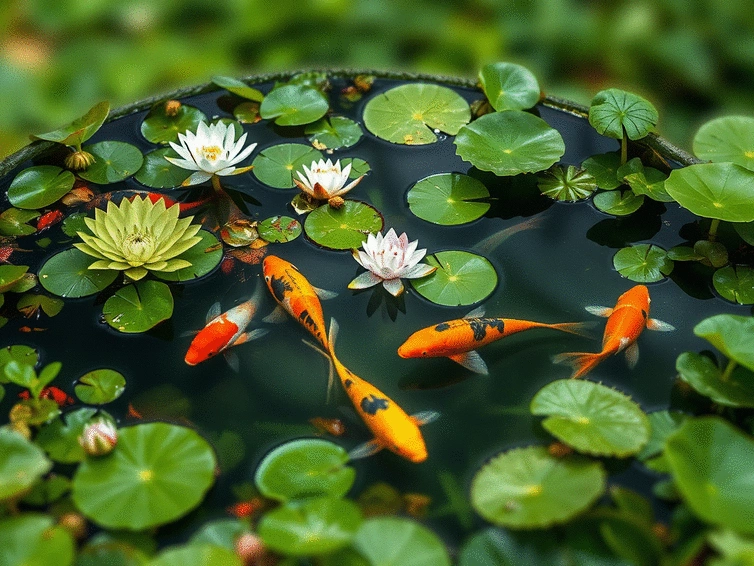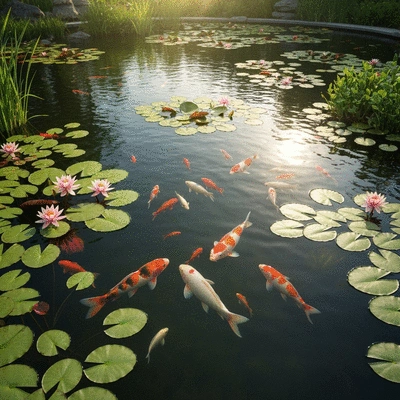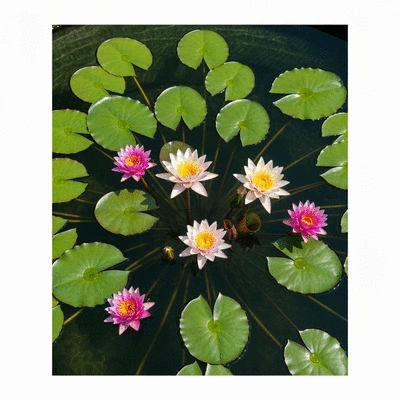Improved Water Quality
Aquatic plants absorb excess nutrients like nitrates and phosphates, which are primary causes of algae blooms. This natural filtration keeps the water clear and clean, reducing the need for chemical treatments.

Did you know that aquatic plants can significantly enhance the health and beauty of your koi pond? These natural allies not only provide aesthetic value but also contribute to a thriving ecosystem where your fish can flourish. Let's explore the key lessons you can take away from the world of koi pond naturalization.
Aquatic plants are not just decorative; they play a crucial role in maintaining a balanced and healthy koi pond ecosystem. Below are the key benefits they offer:
Aquatic plants absorb excess nutrients like nitrates and phosphates, which are primary causes of algae blooms. This natural filtration keeps the water clear and clean, reducing the need for chemical treatments.
The root systems of plants act as biological filters, trapping sediments and debris. Additionally, photosynthesis releases oxygen into the water, vital for koi respiration and beneficial bacteria.
Plants provide crucial shelter for koi from predators and harsh sunlight, helping to stabilize water temperature. They also offer breeding grounds for beneficial microorganisms.
A diverse range of aquatic plants supports a wider variety of insects, amphibians, and beneficial bacteria, contributing to a more robust and resilient pond ecosystem.
As a koi pond enthusiast, I've come to appreciate the vital role that aquatic plants play in creating a thriving ecosystem. Naturalizing your pond not only enhances its beauty but also improves its health. Aquatic plants offer numerous ecological benefits, acting as natural filters and habitats for your koi. They help maintain the delicate balance of your pond, contributing to overall water quality and providing shade that keeps the temperature stable.

Additionally, these plants can reduce algae growth, which is often a major concern for koi keepers. By incorporating aquatic plants, you're essentially creating a miniature ecosystem that not only supports your koi but also promotes biodiversity. For more in-depth information on establishing aquatic plants, you can refer to this comprehensive guide from CSU. It's a win-win situation for both the fish and the environment!
Naturalizing your koi pond can lead to a healthier and more sustainable aquatic environment. When you allow plants to thrive, they contribute to nutrient uptake and oxygenation, which are essential for fish health. But what exactly are the benefits of naturalization? Here are some key points:
By incorporating these plants, you’re not just making your pond look beautiful; you’re creating a thriving habitat for your koi and their aquatic friends!
Creating a balanced koi pond involves several essential elements that work together to sustain your aquatic life. Understanding these factors is crucial for any koi keeper. Here are the key components you should focus on:
Each of these elements plays a significant role in ensuring your koi live in a healthy environment. Keep in mind that maintaining this balance requires continuous attention, especially as seasons change!
Choosing the right aquatic plants for your koi pond is crucial for both aesthetic appeal and ecological health. Native plants are particularly beneficial as they are adapted to your local climate and soil conditions. Here’s a list of some region-specific plants that can enhance your pond:
Integrating these native plants not only benefits the koi but also supports local wildlife and biodiversity. Plus, it’s a wonderful way to connect with your natural surroundings!
Aquatic plants are not just pretty additions; they significantly contribute to the health of your koi. Through nutrient uptake and water aeration, these plants help create a stable environment where your fish can thrive. Here’s how they benefit your koi:
For more details on how aquatic plants contribute to a healthy ecosystem, you can read about their ecological role in this article from the Aquatic Plant Management Society. In my experience, healthy koi make for a beautiful pond, so investing in aquatic plants is one of the best choices you can make!
Among the many beautiful aquatic plants, water lilies and lotus are standout favorites. They not only enhance the visual appeal of your pond but also maintain ecological balance. Here's a closer look at these popular plants:

Incorporating these plants will not only beautify your koi pond but also contribute to a healthy environment for your fish. As I always say, a happy koi is a beautiful koi!
As you consider naturalizing your koi pond, what aquatic plants are you most excited to add? Select one option below:
Aquatic plants are crucial for koi ponds because they improve water quality by absorbing excess nutrients, enhance filtration, provide oxygen, offer shade and shelter for koi, and promote overall biodiversity within the pond ecosystem.
Aquatic plants absorb excess nutrients like nitrates and phosphates from the water, which are common causes of algae blooms. This natural filtration keeps the water clear and reduces the need for chemical treatments.
Naturalizing a koi pond leads to a healthier and more sustainable environment by improving water quality through nutrient uptake and oxygenation, enhancing biological filtration, and creating habitats for beneficial microorganisms and wildlife.
Recommended aquatic plants include Water Lilies and Lotus for shade and aesthetic appeal, and Blue Flag Iris and Pickerel Rush for vertical interest and attracting pollinators. Choosing native, region-specific plants is always beneficial.
Plants contribute to koi health by creating a stable environment. They absorb harmful nutrients, aerate the water by releasing oxygen during photosynthesis, and provide shelter from predators and harsh sunlight, which helps stabilize water temperature.
Creating a balanced ecosystem in your koi pond is not just about aesthetics; it's fundamental to the health and longevity of your koi! Naturalizing your pond with aquatic plants enriches this environment, providing numerous benefits. These plants help improve water quality, enhance biodiversity, and create a peaceful haven for your fish and other wildlife. For further insight into the benefits of natural pond ecosystems, you can explore resources like those compiled by PMC NCBI on ecological balance.
When you introduce aquatic plants into your koi pond, you're not only beautifying the space but also supporting a healthy aquatic ecosystem. Plants play a pivotal role in maintaining water quality by absorbing excess nutrients and providing oxygen, which is vital for koi and other pond inhabitants. Let's explore why fostering this natural environment is key to your koi pond's success!
Now that you understand the significance of aquatic plants in your koi pond, it's time to take action! I encourage you to implement the steps outlined in this guide, which will help you create a thriving aquatic habitat. Remember, ongoing education and care are essential for maintaining a healthy pond ecosystem.
Sharing your experiences not only enriches your journey but also contributes to the knowledge of fellow koi enthusiasts. Have you started your naturalization process yet? I’d love to hear about your progress and any challenges you encounter along the way. Let’s work together to cultivate beautiful, sustainable koi ponds that enhance our outdoor living spaces!
Here is a quick recap of the important points discussed in the article:
Koi Pond Water Quality Solutions

Did you know that maintaining optimal water quality can significantly extend the lifespan of your ko
Naturalizing Your Koi Pond Plants

Did you know that aquatic plants can significantly enhance the health and beauty of your koi pond? T
Koi Pond Shape and Size Guide
Koi Pond Water Quality Solutions
Naturalizing Your Koi Pond Plants
Koi Pond Equipment: Pumps, Filters, Liners
Koi Pond Water Test Kit Guide